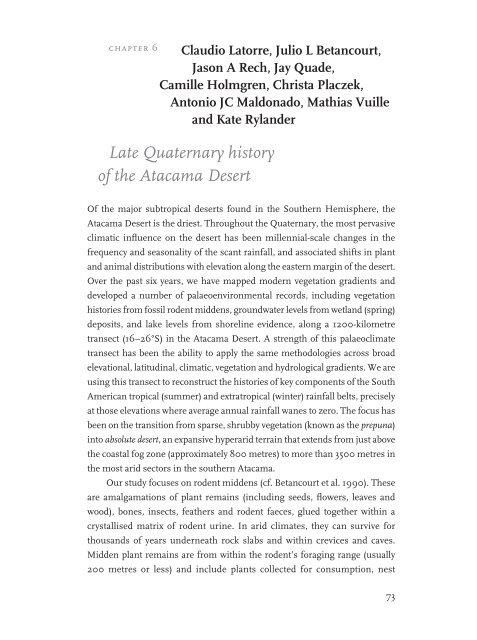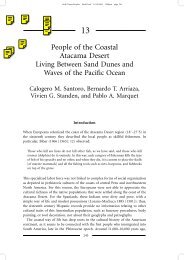Late Quaternary History of the Atacama Desert.
Late Quaternary History of the Atacama Desert.
Late Quaternary History of the Atacama Desert.
You also want an ePaper? Increase the reach of your titles
YUMPU automatically turns print PDFs into web optimized ePapers that Google loves.
chapter 6Claudio Latorre, Julio L Betancourt,Jason A Rech, Jay Quade,Camille Holmgren, Christa Placzek,Antonio JC Maldonado, Mathias Vuilleand Kate Rylander<strong>Late</strong> <strong>Quaternary</strong> history<strong>of</strong> <strong>the</strong> <strong>Atacama</strong> <strong>Desert</strong>Of <strong>the</strong> major subtropical deserts found in <strong>the</strong> Sou<strong>the</strong>rn Hemisphere, <strong>the</strong><strong>Atacama</strong> <strong>Desert</strong> is <strong>the</strong> driest. Throughout <strong>the</strong> <strong>Quaternary</strong>, <strong>the</strong> most pervasiveclimatic influence on <strong>the</strong> desert has been millennial-scale changes in <strong>the</strong>frequency and seasonality <strong>of</strong> <strong>the</strong> scant rainfall, and associated shifts in plantand animal distributions with elevation along <strong>the</strong> eastern margin <strong>of</strong> <strong>the</strong> desert.Over <strong>the</strong> past six years, we have mapped modern vegetation gradients anddeveloped a number <strong>of</strong> palaeoenvironmental records, including vegetationhistories from fossil rodent middens, groundwater levels from wetland (spring)deposits, and lake levels from shoreline evidence, along a 1200-kilometretransect (16–26°S) in <strong>the</strong> <strong>Atacama</strong> <strong>Desert</strong>. A strength <strong>of</strong> this palaeoclimatetransect has been <strong>the</strong> ability to apply <strong>the</strong> same methodologies across broadelevational, latitudinal, climatic, vegetation and hydrological gradients. We areusing this transect to reconstruct <strong>the</strong> histories <strong>of</strong> key components <strong>of</strong> <strong>the</strong> SouthAmerican tropical (summer) and extratropical (winter) rainfall belts, preciselyat those elevations where average annual rainfall wanes to zero. The focus hasbeen on <strong>the</strong> transition from sparse, shrubby vegetation (known as <strong>the</strong> prepuna)into absolute desert, an expansive hyperarid terrain that extends from just above<strong>the</strong> coastal fog zone (approximately 800 metres) to more than 3500 metres in<strong>the</strong> most arid sectors in <strong>the</strong> sou<strong>the</strong>rn <strong>Atacama</strong>.Our study focuses on rodent middens (cf. Betancourt et al. 1990). Theseare amalgamations <strong>of</strong> plant remains (including seeds, flowers, leaves andwood), bones, insects, fea<strong>the</strong>rs and rodent faeces, glued toge<strong>the</strong>r within acrystallised matrix <strong>of</strong> rodent urine. In arid climates, <strong>the</strong>y can survive forthousands <strong>of</strong> years underneath rock slabs and within crevices and caves.Midden plant remains are from within <strong>the</strong> rodent’s foraging range (usually200 metres or less) and include plants collected for consumption, nest73
















